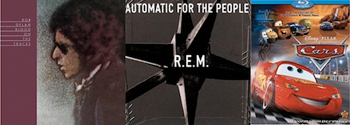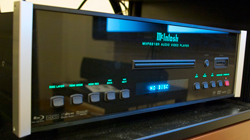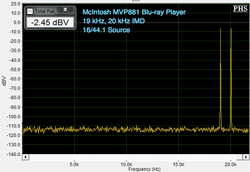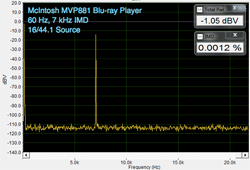Introduction
McIntosh is one of the most distinctive, and iconic, brands in all of Hi-Fi. Sporting a look that seemingly has never changed, they are most well known for their two channel amps and preamps, but also have a full line of home theater components as well. Their MVP881 Universal Blu-ray player is a disc player that can handle virtually any format you throw at it with an analog section designed by McIntosh. How would it stack up against some other universal Blu-ray players?
Specifications
- Design: Universal Blu-ray Player
- Codecs: CD, DVD-A, SACD
- Audio Section: Three 192kHz/24-bit PCM/DSD Stereo DACs, 115 dB SNR
- Connections : Two HDMI 1.3, Component Video, S-Video, Composite Video, Optical Audio, Coaxial Audio, 7.1 RCA Audio, Stereo Balanced Audio, Stereo RCA Audio, USB, Ethernet, RS-232, SD Card
- Dimensions: 5.4″ H x 17.5″ W x 16.5″ D
- Weight: 26 Pounds
- MSRP : $8,000
- McIntosh
Design And Setup
The UPS delivery guy was quite impressed to see a piece of McIntosh gear arriving at my house. When I said the massive box he had lugged up the stairs was a Blu-ray player and not an amplifier, he was astonished. The MVP881 is the largest, and heaviest, Blu-ray player that I have used, tipping the scales at over 26 lbs. and over 40 lbs. shipped. As soon as you look at the front panel, you will not mistake it for any other brand. Easily the best looking player I’ve had in my equipment rack, the MVP881 has the classic McIntosh styling with a green logo, blue accents, and that flat, glass black front.
The rear of the player contains virtually any connection you might need for your system: dual HDMI outputs, 7.1 multichannel outputs, separate RCA and Balanced stereo outputs, optical and coaxial audio, Ethernet, RS-232, even 12V and IR inputs. As you’d expect for something of this level, everything is gold plated and incredibly solid. There is also a rather large exhaust fan on the right side of the rear, but I never heard it during use, and since a larger fan can spin slower and more quietly than a smaller fan to move as much air, I imagine it will be quiet for most users as well.
The front panel has the user controls for playback, as well as HDMI options, and an SD card slot. The card slot can be used for playback of audio or picture files, but also must be used with the enclosed SD card to support BD Live. It’s really unfortunate that a player shipping now goes this route instead of having the memory built onto the board, or at least has an alternate slot in the rear for BD Live, leaving the front SD slot open for media. The front controls were a bit strange in that the Open/Close button was next to the Power button, not next to the drive tray as you would expect. Also the HDMI options being set by buttons on the front of the player instead of in the menu system was a bit different than usual, and was a little bit confusing at first.
Setup of the MVP881 was fairly straight forward as it is for most players now. I did hook up both the unbalanced and balanced analog outputs in addition to the HDMI output since the analog section is one of the main highlights of the McIntosh player. The settings in the menus let me assign different colorspaces to each of the HDMI outputs, which was a nice feature to have. Unfortunately, other settings that you would expect to find for those HDMI outputs, like resolution, are adjusted by using the buttons on the front of the unit. Separating out these options, without much reasoning behind why, makes for a bit of a confusing experience. The colorspace option also only mentions “YCbCr” and not which format it uses, but my testing found that it’s 4:4:4 and not 4:2:2.
I didn’t utilize the 7.1 analog outputs from the MVP881 as I prefer to use Audyssey room correction on my multichannel sources, and my processor does not do A-D conversion on the multichannel input. However, the MVP881 does feature full bass management for all 7.1 channels over analog outputs for those people using it in an all-analog system, or that prefer the DACs in the MVP881 to the DACs in their receiver or processor.
In Use
After admiring the MVP881 and setting it up, it was finally time to use it. I began by testing out the CD and SACD playback of the McIntosh using its analog outputs. In comparison to my reference Oppo players (83SE, 95), the soundstage of the McIntosh was perhaps a touch narrower, though it was only noticeable with extensive A-B comparisons. The highs from the McIntosh were a bit mellower and relaxed on the MVP881, with the bass being a big tighter as well. Going back and forth between the players while listening to REM’s Automatic for the People, I really could not pick a favorite between the two. While this is good since the Oppo players are very well regarded for their CD playback capabilities, it’s also underwhelming as the McIntosh has a retail price far beyond the Oppo, so you would hope it would distinguish itself more.

On SACD playback with Bob Dylan’s “Blood On The Tracks”, the differences were even more minute, and I’d be hard pressed to find a difference between the two. When comparing the CD layer to the SACD layer, everything was better detailed, with far more definition and air around the instruments, and a more defined soundstage. If you blindfolded me and asked me to distinguish between the two players for SACD playback, I’m fairly certain that I’d score no better than 50% on the test.
Moving onto Blu-ray performance, the first impression that the MVP881 makes is that it’s a bit slow compared to other current players. Load times for most discs that I tested were often a minute or more behind other players, and menu navigation was pokey as well. Once a film started then everything was fine, but it just took a while to get there compared to other players.
I made the great mistake recently of seeing if my son would watch any movies with me, starting with Cars. Since then, Cars has become almost a daily habit for him and I, but at least he picked something of reference quality to watch. On the MVP881 the image was sharp and clear, as you’d expect from a Pixar title on Blu-ray, and the lossless soundtrack exploded from the speakers, bringing you inside the racecars on the track. Aside from the loading time, films looked and sounded fantastic on the MVP881.
On The Bench
Given all the engineering and effort put into the MVP881, the results on the bench were disappointing to shocking. The first thing I noticed, which doesn’t show up on the bench tests, is that over HDMI at either YCbCr (4:4:4) or RGB colorspaces, the MVP881 is losing fine chroma data. On the Spears and Munsil Chroma Multiburst pattern, it is clearly losing both horizontal and vertical details over HDMI, and vertical detail over Component. This is the only player I have seen this on and talking to McIntosh they believed it might just be my unit. Unfortunately, I tracked down another unit to use that also exhibited the same behavior, so I have to assume that the MVP881 is losing chroma data in its initial conversion from 4:2:0 and it was not just my unit.
For the tests that are on the benchmark results table, I have some additional details about the results:
– When the Progressive mode was set to Auto, it would fail to deinterlace 2:2 video content correctly, so I had to set it to Mode 2. Unfortunately it would then fail the jaggies test in this mode until I went back to Auto, so you really have to pick your poison here.
– Curiously, video content passed over Component video at 720p resolution in Auto mode, but failed at 1080p over HDMI.
– It did a good job reducing video noise, but adjusting the noise reduction control had no effect on mosquito noise.
– The layer change was a good 1.5-2 seconds long. On most current players I can’t even notice this change unless I watch it repeatedly, but it was very obvious on the MVP881.
– It failed two of our four tests for the Chroma Upsampling Error (CUE). On one of them, it caused the image on the screen to shake badly, which I had never seen before.
– Even though it does support 4:4:4 output over HDMI, it receives a fail on this for only referring to it in the menus as YCbCr and providing no indication if it is 4:2:2 or 4:4:4.
– On the good side, it’s performance over Component on the scope was very impressive and McIntosh obviously invested some time and money on that aspect of the player.
While we would have loved to provide results using our new HDMI Analysis, the McIntosh MVP881 will not read a BD-R or BD-RE disc, and so it would not load the test patterns for those tests.
From the load times chart above, you can see that the McIntosh is slower than other players recently reviewed as well.
Since the McIntosh is a universal player, with a lot of work on the analog audio section, I also ran it through our standard audio benchmarks. I used the balanced audio outputs for the test, and all test tones were 16/44.1 CD audio.
With the 1 kHz tone, there is only the smallest peak at 2 kHz that is over 100 dB below the primary tone, and otherwise exhibits a noise floor that is right around 115 dB below the primary harmonic.
The results here are almost the same as 1 kHz above, only with no secondary harmonic to speak of. These are really excellent results for the THD+N tests from McIntosh here.
Once again, we see no B-A peaks or other issues on the IMD test, and the performance is practically perfect.
Just like the other IMD test, there are no secondary harmonics at all, and a very low noise floor. As a CD player, the MVP881 is nearly perfect on the bench and provides fantastic results.
Conclusions
The MVP881 is better constructed than any Blu-ray player I’ve used to date, and sounds wonderful as an audio player. Unfortunately, it has DVD and Blu-ray performance that leaves a lot to be desired, and a menu system that really needs to be redone. Other players offer far better DVD and Blu-ray playback than the McIntosh, as well as faster load times and online content to boot. As much as I looked forward to having my first component from McIntosh in house, I was left disappointed by the overall results.










